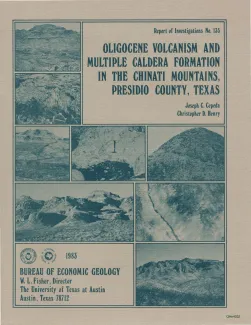
Publication Details
Geolocation:
Get the Publication
$17.00
Abstract/Description:
The Chinati Mountains caldera, which lies in Trans-Pecos Texas in the southern Basin and Range Province, was formed by eruption of the Mitchell Mesa Rhyolite. The caldera (30 km by 20 km) is part of a larger Oligocene volcanic province that includes Trans-Pecos Texas and extends to the Sierra Madre Occidental of western Mexico. Volcanism in the Chinati Mountains area began several million years before formation of the Chinati Mountains caldera. Rocks of the Morita Ranch Formation, Infiernito caldera, and Shely Group ring the caldera on the south, east, and north. After its collapse, the caldera was filled by rhyolitic to trachytic lava flows and an ash-flow tuff of the Chinati Mountains Group. These include, from oldest to youngest, the lower trachyte, middle trachyte, lower rhyolite, upper trachyte, and upper rhyolite (ash-flow tuff). The Chinati Mountains Group was then intruded by the West Chinati Stock, the resurgent dome of the caldera. Three cycles of rhyolitic to trachytic magmatism, all derived from a zoned magma chamber, are represented by (1) Mitchell Mesa Rhyolite to lower and middle trachytes, (2) lower rhyolite to upper trachyte, and (3) upper rhyolite to West Chinati Stock. Dominant caldera collapse followed eruption of the Mitchell Mesa Rhyolite, but collapse is also associated with rhyolitic eruptions in the second and third cycles. The entire sequence erupted between 32 and 33 mya. The Chinati Mountains area is the site of one major, inactive silver mine and numerous prospects for silver, lead, zinc, copper, molybdenum, uranium, and fluorite. The Shafter silver district produced 31 million ounces of silver from Permian dolomitic limestones just south of the southern boundary of the caldera. Major prospects are associated with a quartz-monzonite porphyry intrusion (copper-molybdenum) just west of Shafter and with the West Chinati Stock (silver, lead, zinc, copper, and fluorite). All mineralization is probably genetically related to the caldera.